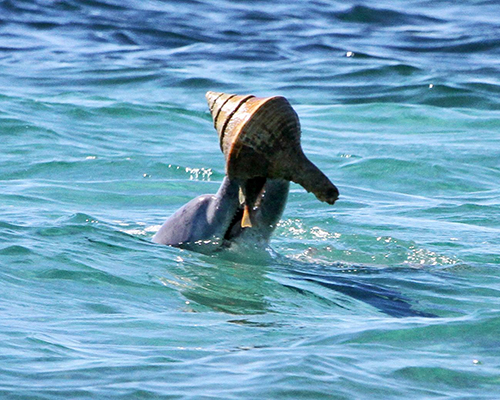The scientists have been studying the dolphins of Shark Bay, Western Australia, for almost 40 years and, in the mid-1990s, they were able to document the first instances of an extraordinary new foraging technique called “shelling”.
Co-author Dr Simon Allen, of Bristol’s School of Biological Sciences, said shelling was a tactic used by dolphins to target prey that hide inside large empty shells of giant sea snails in Shark Bay. “The dolphins chase the fish into the shell, then insert their beak into the opening and lift the shell to the surface, shaking it about until the trapped prey falls into their jaws,” Dr Allen said.
In a collaborative project led by the University of Zurich, the team conducted boat-based surveys in the western gulf of Shark Bay between 2007 and 2018 to quantify how shelling behaviour spread across the population. From over 5,000 dolphin group encounters they identified more than 1,000 different individuals. A total of 42 shelling events were documented, performed by 19 individual dolphins.
Dr Allen said foraging techniques in Shark Bay were typically passed on from dolphin mothers to their offspring in what researchers refer to as vertical social transmission. “This transmission between generations was considered the primary way in which young dolphins learned their foraging methods,” he explained.
But the new study demonstrates that some of Shark Bay’s dolphins have actually learned this foraging method outside the mother-calf bond, from their peers.
“This study sets an important milestone, as it shows that the cultural behaviour of dolphins and other toothed whales may be more similar to that of great apes, including humans, than previously thought. Although their evolutionary histories and the environments they inhabit are vastly different, there exist striking similarities between cetaceans and great apes. Both taxa are long-lived, have high cognitive abilities, and they are capable of innovation and social learning,” says Allen.
These findings represent the first quantitative evidence of non-vertical transmission of a foraging tactic in toothed whales, providing further evidence of cultural similarities between dolphins and great apes. Chimpanzees and humans have also demonstrated a broad range of socially learned foraging behaviour outside the mother-calf bond.
The study was conducted by Dr Sonja Wild for her PhD through the University of Leeds. Dr Wild is now a postdoctoral researcher based at the Centre for the Advanced Study of Collective Behaviour at the University of Konstanz in Germany.
Dr Wild said: “The results are quite surprising, as dolphins tended to be conservative, with calves following a ‘do-as-mother-does’ strategy for learning foraging behaviour.
“However, our results show that dolphins are definitely capable, and in the case of shelling, also motivated to learn new foraging tactics outside the mother-calf bond,” she added. “This opens the door to a new understanding of how dolphins may be able to adapt to changing environments, as learning from one’s peers allows for the rapid spread of novel behaviour across populations.
“For example, an unprecedented marine heatwave was responsible for wiping out Shark Bay’s critical seagrass habitat in 2011. There was a subsequent die-off of fish and invertebrates, including the gastropods that live in those giant shells.
“While we can only speculate as to whether this prey depletion gave the dolphins a boost to adopt new foraging behaviour from their associates, it seems quite possible that an abundance of dead giant gastropod shells may have increased learning opportunities for shelling behaviour.”
Paper
'Integrating genetic, environmental and social networks to reveal transmission pathways of a dolphin foraging innovation' by Sonja Wild, William J.E. Hoppitt, Simon J. Allen, Michael Krützen in Current Biology
